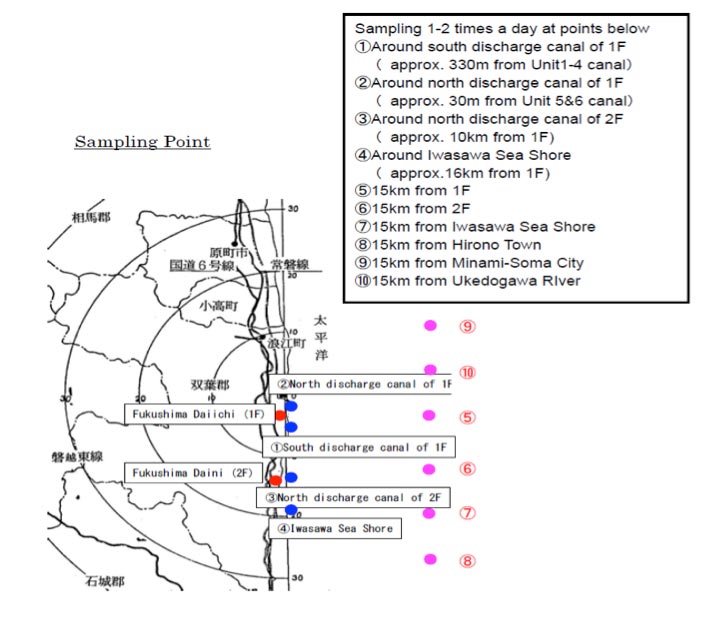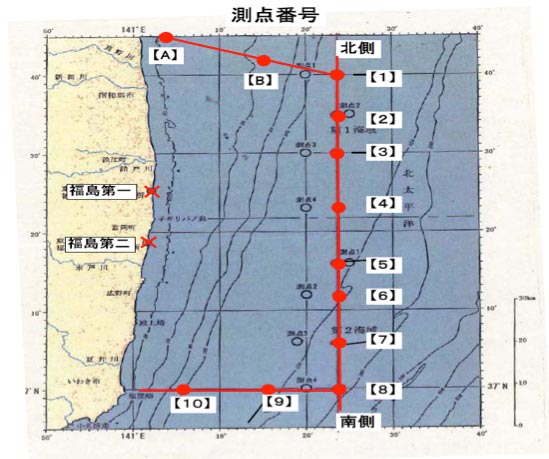→ Chronology of Updates:
2 June | 12-18 May | 4-11 May | 5 May | 3 May | 2 May | 28 April | 27 April | 26 April | 21 April | 20 April | 19 April | 18 April | 15 April | 14 April | 13 April | 12 April | 11 April | 10 April | 9 April | 8 April | 7 April | 6 April | 5 April | 4 April | 3 April | 2 April | 1 April | 31 March | 30 March | 29 March | 28 March | 27 March | 26 March | 25 March | 24 March | 23 March | 22 March | 21 March | 20 March | 19 March | 18 March | 17 March | 16 March | 15 March | 14 March | 13 March | 12 March | 11 March | Full Update
IAEA BRIEFING ON FUKUSHIMA NUCLEAR ACCIDENT (13 April 2011, 14:30 UTC)
Presentation:
→ Summary of Reactor Status
On Wednesday, 13 April 2011, the IAEA provided the following information on the current status of nuclear safety in Japan:
1. Current Situation
Overall, the situation at the Fukushima Daiichi plant remains very serious but there are early signs of recovery in some functions such as electrical power and instrumentation.
There have been no changes concerning the provisional INES Level 7 rating and protective measures as reported in yesterday's brief.
Earthquakes of 11 and 12 April
The IEC received information from the IAEA International Seismic Safety Center on the following recent earthquakes (equal or higher than magnitude Mw = 6.0) which occurred in the time interval from 23:08 UTC on 11 April to 05:07 UTC on 12 April:
i) At 23:08 UTC, 11 April, an earthquake with a magnitude of 6.2 occurred offshore of the East Coast of Honshu, Japan, at a depth of 13.1 km. Distances from the epicentre of the earthquake to nuclear power plant sites were: 188 km to Tokai, 217 km to Fukushima Daini, 229 km to Fukushima Daiichi, 236 km to Hamaoka and 285 km to Kashiwazaki-Kariwa.
ii) At 05:07 UTC, 12 April, an earthquake with a magnitude of 6.0 occurred inland east of Honshu, Japan, at a depth of 10.6 km. Distances from the epicentre of the earthquake to nuclear power plant sites were: 46 km to Fukushima Daini, 53 km to Fukushima Daiichi, 72 km to Tokai, 165 km to Onagawa and 179 km to Kashiwazaki-Kariwa.
The NISA Press Release regarding the earthquake which occurred on 12 April, states that there was no effect on the following nuclear power plant sites: Fukushima Daiichi, Fukushima Daini, Tokai Daini, Onagawa. Other nuclear related facilities (Mitusubishi Nuclear Fuel, Nuclear Fuel Industries, Ltd., JAEA Tokai and its recycling plant) in the Tokai area were reported to be safe by their respective operators.
Changes to Fukushima Daiichi Plant Status
On 11 April, a fire broke out in the housing outlet structure for cooling water for Units 1 to 4. The fire was extinguished manually. No consequences were identified in terms of release of radioactive material, cooling of the plants, or values recorded by radiation monitoring posts.
In Unit 1 fresh water is being continuously injected into the RPV through the feed-water line at an indicated flow rate of 6 m3/h using a temporary electric pump with off-site power. In Units 2 and 3 fresh water is being continuously injected through the fire extinguisher lines at an indicated rate of 7 m3/h using temporary electric pumps with off-site power.
Nitrogen gas is being injected into the Unit 1 containment vessel to reduce the possibility of hydrogen combustion within the containment vessel. The pressure in this containment vessel has stabilised. The pressure in the RPV is increasing as indicated on one channel of instrumentation. The other channel shows RPV pressure as stable.
In Units 2 and 3 Reactor Pressure Vessel and Drywell pressures remain at atmospheric pressure.
RPV temperatures remain above cold shutdown conditions in all Units, (typically less than 95 °C). In Unit 1 temperature at the feed water nozzle of the RPV is 206 °C and at the bottom of the RPV is 119 °C. In Unit 2 the temperature at the feed water nozzle of the RPV is 165 °C. The temperature at the bottom of RPV was reported as 208 °C (this measurement has been available since 12 April). In Unit 3 the temperature at the feed water nozzle of the RPV is 99 °C and at the bottom of the RPV is 116 °C.
There has been no change in status in Units 4, 5 and 6 and the Common Spent Fuel Storage Facility.
2. Radiation Monitoring
On 12 April, deposition of both iodine-131 and cesium-137 was detected in 7 and 6 prefectures respectively. The values reported for iodine-131 ranged from 1.6 to 460 Bq/m2 and for cesium-137 from 31 to 700 Bq/m2. The highest deposition was observed in the Ibaraki prefecture.
Gamma dose rates are measured daily in all 47 prefectures, the values tend to decrease. For Fukushima, on 12 April a dose rate of 2.1 µSv/h, for the Ibaraki prefecture a gamma dose rate of 0.14 µSv/h was reported. The gamma dose rates in all other prefectures were below 0.1 µSv/h.
Only in a few prefectures, iodine-131 or cesium-137 is detectable in drinking water at very low levels. As of 12 April, a restriction for infants related to iodine-131 (100 Bq/l) is in place as a precautionary in a small scale water supply in one village of the Fukushima prefecture.
MEXT reported on measurements of strontium-89 (half-life: 50.5 days) and strontium-90(half-life: 28.8 years) in three samples taken in one village in the Fukushima prefecture on 16 March. The activities in soil for Sr-89 ranged from 13 and 260 Bq/kg and for Sr-90 between 3.3 and 32 Bq/kg. Sr-90 was also distributed globally during nuclear weapons' testing in the atmosphere, typical global levels of Sr-90 in surface soils are in the order of one to a few becquerel per kg. Strontium was also measured in plant samples in four others villages, with values ranging from 12 to 61 Bq/kg for Sr-89 and 1.8 to 5.9 Bq/kg for Sr-90.
On 12 April, the IAEA Team made measurements at 7 different locations in the Fukushima area at distances of 32 to 62 km, North and Northwest from the Fukushima nuclear power plant. At these locations, the dose rates ranged from 0.6 to 1.6 µSv/h. At the same locations, results of beta-gamma contamination measurements ranged from 0.6 to 1.7 Megabecquerel/m2.
NISA reported on 12 April that the three workers who had previously been exposed to high dose rates while working in the turbine building of Unit 3 have undergone further medical checks. No negative outcomes were identified. In the case of the two workers who received doses of a few Sievert to their legs as a result of walking in contaminated water, medical tests showed no evidence of either skin burns or erythema.
Analytical results related to food contamination were reported by the Japanese Ministry of Health, Labour and Welfare on 12 April that covered a total of 55 samples taken on 8 and 10 to 12 April. Analytical results for 53 of the samples of various vegetables, fruit (strawberries), seafood and unprocessed raw milk in eight prefectures (Chiba, Fukushima, Gunma, Ibaraki, Kanagawa, Niigata, Saitama and Yamagata) indicated that I-131, Cs-134 and/or Cs-137 were either not detected or were below the regulation values set by the Japanese authorities. In Ibaraki prefecture for samples taken on 11 April, one sample of seafood (sand lance) was above the regulation values set by the Japanese authorities for I-131 and one sample of spinach was above the regulation values set by the Japanese authorities for Cs-134/Cs-137.
On 13 April, the Prime Minister of Japan requested the Governor of Fukushima prefecture to restrict the consumption of shiitake mushrooms (grown on logs in open fields only) produced at Iitate-village until further notice. Instructions were also issued to restrict the distribution of shiitake mushrooms (grown on logs in open fields only) produced in the cities of Date, Soma, Minamisoma, Tamura and Iwaki; the towns of Shinchi, Kawamata, Namie, Futaba, Ookuma, Tomioka, Naraha and Hirono; and the villages of Iitate, Katsurao and Kawauchi until further notice.
3. Marine Monitoring
TEPCO Monitoring Programme
TEPCO is conducting a programme for seawater (surface sampling) at a number of near-shore and off-shore monitoring locations. (See Map 12: TEPCO Seawater Sampling Locations).
On same days, two samples were collected at the same sampling point, a few hours apart and analysed separately.
Until 3 April a general decreasing trend was observed at the sampling points TEPCO 1 to TEPCO 4. After the discharge of contaminated water on 4 April, a temporary increase has been reported.
On 13 April new data for samples collected on 11 April at TEPCO 1 - 10 sampling points have been reported. As for the near-shore stations TEPCO 1, 3 and 4 levels of I-131 and Cs-137 below 1.5 kBq/l have been reported. At TEPCO 2, for both I-131 and Cs-137 concentrations of about 7 kBq/l were measured.
As for the six TEPCO stations 15 km offshore, at TEPCO 5 - 6 - 10 the concentration of I-131 was below 0.3 kBq/l and that of Cs-137 below 0.2 kBq/l. At TEPCO 7 and 8, I-131 and Cs-137 below 0.05 kBq/l below 0.02 kBq/l were measured. At TEPCO 9 concentrations of about 1 kBq/l of both I-131 and Cs-137 were recorded.
MEXT Off-shore Monitoring Programme
MEXT initiated the off-shore monitoring program on 23 March and subsequently points 9 and 10 were added to the off-shore sampling scheme. On 4 April, MEXT added two sampling points to the north and west of sampling point 1. These are referred to as points A and B. (See Map 13: MEXT Seawater Sampling Locations).
On 13 April new data for samples collected on 11 April at MEXT 2, 4, 6, 8, 10 an B sampling points have been reported.
Cs-137 was only detected at MEXT 4 at a concentration level of about 70 Bq/l.
I-131 concentration of about 90 Bq/l was measured at Station MEXT 4. At MEXT 6, 8, 10 and B, I-131 below about 15 Bq/l was reported.
Map 12: TEPCO Seawater Sampling Locations:

Map 13: MEXT Seawater Sampling Locations:

4. IAEA activities
No new activities to report.

